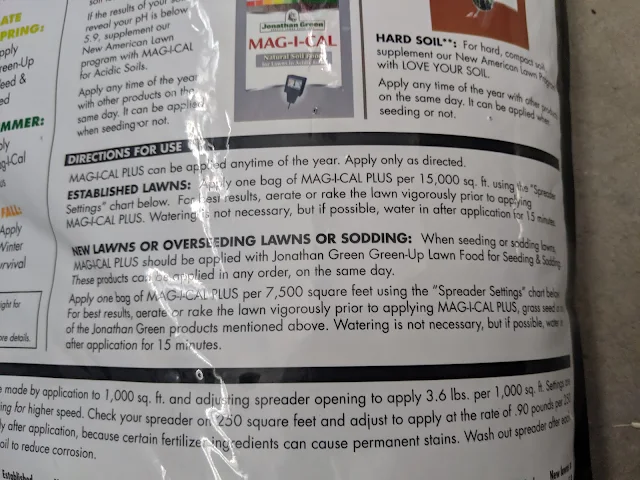Feeding Our Lawn With Mag-I-Cal Plus - September 2019
Starting this Spring and continuing this Summer, I've chronicled my experiences with our lawn and the process, materials and thinking that have gone into it. This is the first time that I've spent anything more than a passing thought about the turf, the soil and how to best tend to it as the seasons change.
- Started in Spring with a Wild Onion removal - digging them out.
- Used a calculator to time my application of pre-emergent Crabgrass preventer (without food!)
- Started to use an organic fertilizer - Milorganite on the yard - instead of synthetics.
- Got serious about my weed spraying with a blue pattern indicator.
- Then I tested my soil and got a baseline on the front and back.
- I added some Ironite (2x) this Summer to keep the lawn green.
- Cut the front yard higher than I've ever cut in the past.
- Earlier this Summer, I bought and spread a big bag of granular Humic Acid.
- And most recently, I put down a second application of pelletized lime to make the backyard a little less hospitable to the Wild Onion next Spring.
- By August, the front yard was looking (mostly!) green, lush and thick.
In fact, I'd say that our front yard - the main section is looking better than any lawn we've ever had. Admittedly, I haven't - in the past - paid too much attention to the lawn like I am this season. But, I still think it looks better.
I mentioned that I've conditioned the soil a few times. Starting with adding some Lime this Spring, then again this Summer and then earlier this Summer with that Anderson's DG granular Humic Acid. In the post where I talked about Humic Acid, I included the benefits of humic including the ability for other applications (like fertilizer) to do their jobs better. That idea resonated with me and despite me not knowing what kind of impact it was having, I'm glad I applied it.
The research on humic acid lead me to another product: this Mag-I-Cal Plus from Jonathan Greene. I found it up at the Ace Hardware in Twin Lakes, Wisconsin.
You can see in the very top photo of this post what they bill the stuff as: "Natural Soil Food for lawns in acidic and hard soils". Guess what? I have both clay. And - despite the soil tests saying my pH was *good*, I want my soil to be less acidic to make it harder on the Wild Onions. So, when I came across this stuff on a lawn care forum online, I jumped at trying it.
 |
| via the Jonathan Green product listing page. |
Lots there to like, right?
Increases soil pH. Check.
Breaks up clay. Check.
Stimulates soil microbial activity. Check, I guess??
And is natural and safe for kids/pets. Check plus.
On the back of the 54# bag, the fine folks at Jonathan Greene lay out their annual cycle - which conveniently maps back to their product offerings. They've mapped this Mag-i-Cal Plus to their "Summer" season. I'm a little late for August, but I'm putting it down along with my late Summer/Early Fall fertilizer (Milorganite).
They mention in the application that it can be applied at any time, but they do recommend an aeration or raking prior to applying. That's something that I've been doing by hand with a little step-on core aerator, but I am thinking that if I can catch a guy in the neighborhood with a core aerator, I'll get him to come give my yard a plug. That will be AFTER this application this weekend, though. I'm thinking that if I get this down before the Fall leaves come, it will be past the thatch layer and not be taken up with my leaf removal.
And, finally, here's the ingredients. Some expected stuff like Calcium, iron and sulfur. But....then there's these other things: Humic Acid (yea!), polyhydroxycarboxylic Acids (what are those?!) and Wood biochar (the lawncare nerds always talk about this!). So, we're getting a little bit of those things in there...which I think I'm happy about.
Right now, I'm thinking that this can/should be a part of my annual process. Putting it down once a year? Then repeating the separate granular humic acid in the Spring, too? I'm hoping that between this application and even more lime that I intend to apply before Winter, we'll see some movement in the pH on the soil tests next year. And, hopefully, some remediation of the Wild Onions along with it.







Comments
Post a Comment
Be nice to each other here.